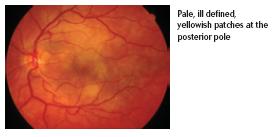This bilateral, acute, self-limiting disorder is characterised by grey-white lesions scattered throughout the posterior pole, in association with mild to marked visual loss. It has been classified among the 'white dot syndromes', characterised by multiple chorioretinal lesions, visual loss and photopsia, most often in young adults.  APMPPE affects men and women equally, usually between 20 and 40 years of age. Although no cause has been identified, there is an association with recent systemic illness, suggesting ocular involvement in a more generalised inflammatory or immune process. Antecedent upper respiratory tract infections are most common; other reported associations include cerebral vasculitis, mumps and streptococcal infection.
APMPPE affects men and women equally, usually between 20 and 40 years of age. Although no cause has been identified, there is an association with recent systemic illness, suggesting ocular involvement in a more generalised inflammatory or immune process. Antecedent upper respiratory tract infections are most common; other reported associations include cerebral vasculitis, mumps and streptococcal infection.
It has also been suggested that patients with certain HLA types are predisposed to this condition. Similarly, the pathological process has not been elucidated definitively. One hypothesis is that APMPPE begins with an occlusive choroidal vasculitis, which is followed by a secondary reaction in the overlying retinal pigment epithelium.
Register now to continue reading
Thank you for visiting Optician Online. Register now to access up to 10 news and opinion articles a month.
Register
Already have an account? Sign in here
